In the world of email authentication, we come across fleeting terms like SPF and DKIM. While both SPF and DKIM are email authentication protocols, they work in different ways to ultimately protect your email from spam and impersonation. But can you set up DKIM without SPF? The answer is yes, it can. As independent protocols, they do not rely on one another for their functionalities and can be implemented without the other being set up for the same domains.
In this article, we would analyze in-depth how DKIM and SPF work so you can select which protocol suits you best, and also provide our expert recommendations at the end. Let’s get started!
What is SPF and how does it protect your emails?
SPF (Sender Policy Framework) allows you to specify which mail servers are permitted to send an email on behalf of your domain or subdomain. An SPF record is a type of DNS record used to validate an email sender’s domain name and to specify which hosts are authorized to send emails on behalf of the domain.
SPF was designed to prevent unauthorized users from sending outbound mail from a different domain than their own, often referred to as “spoofing.” In addition, if an organization has multiple mail servers that accept mail for the same domain, an SPF record helps recipient email systems determine which server to receive incoming mail from. It is one of the most widely used email authentication methods deployed by novices and aficionados alike.
What is DKIM and how does it protect your emails?
DomainKeys Identified Mail (DKIM) is an email authentication method that proves an email was authorized by the owner of that domain. This is done by giving the email a digital signature, using a cryptographic algorithm and key.
Using DKIM, your server will sign all outgoing messages, including email marketing campaigns. This allows recipients of your email to verify your identity so they can trust that your messages were not altered in any way. When you sign a message using DKIM, you attach your private key to the value of a hash function of the complete email header and body. The private key used for signing can only be accessed by authorized senders.
How to set up DKIM without SPF & configure DMARC for my domain?
Well, no. You can implement DMARC even if you have either SPF or DKIM set up for your domain. This is because for your emails to pass DMARC alignment, either DKIM or SPF needs to pass alignment for them and not both. Hence, configuring either of two protocols is enough for you to start with your DMARC deployment endeavor.
However, if your question is whether DMARC implementation is a necessary step when you have already set up DKIM or SPF for your domains, the answer is yes. With DMARC you can control the way your recipients respond to fake emails that appear to be coming from your domain, thereby saving your company’s reputation and credibility and also your clients from falling prey to phishing attacks. Neither DKIM nor SPF alone can protect organizations from social engineering attacks like spoofing, you need DMARC for that.
Generate DMARC record now for free to stop spoofing!
What do the experts recommend?
To gain 100% DMARC compliance, we recommend that you align your emails against both DKIM and SPF authentication protocols instead of just one. In certain exceptional cases such as mailing lists and forwarded emails, due to the involvement of intermediary servers, SPF inevitably fails for those emails. If your mailing system is solely dependent on SPF for authentication, legitimate emails may get lost in transit and fail delivery in the aforementioned cases. Hence, having both protocols in place is always a safer option to ensure smoother deliverability and an additional layer of email security.
Want to try out DMARC for yourself? Get a free DMARC trial for your domains now with a simple sign-up!
- SMTP Yahoo Error Codes Explained - May 1, 2024
- SPF Softfail Vs Hardfail: What’s the Difference? - April 26, 2024
- FTC Reports Email is a Popular Medium for Impersonation Scams - April 16, 2024
